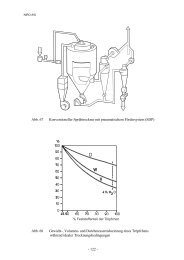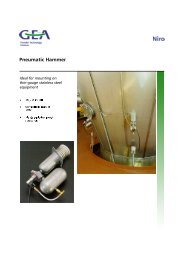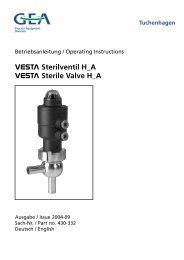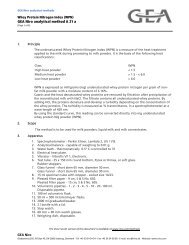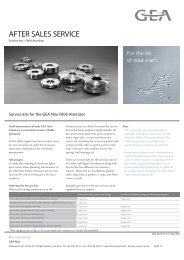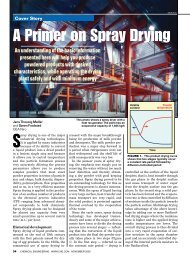41119_Niro jubilaeumsbog_blok_uk - GEA Niro
41119_Niro jubilaeumsbog_blok_uk - GEA Niro
41119_Niro jubilaeumsbog_blok_uk - GEA Niro
Create successful ePaper yourself
Turn your PDF publications into a flip-book with our unique Google optimized e-Paper software.
About development and technological milestones<br />
Demand for better products<br />
The need for more simple plants is slowly<br />
decreasing from the start of the 1960s. Customers<br />
want specially designed plants that can<br />
deliver improved powder properties such as<br />
fast and completely dissolving milk and infant<br />
formula products, coffee and dyestuffs. The<br />
development is towards plants combining<br />
spray drying and fluid bed techniques.<br />
60 | 61<br />
Flue gas<br />
Requirements for flue gas cleaning are increased<br />
in the 1980s, and plants for chemical waste<br />
must be able to handle temperatures over<br />
1,000° C. Today, plants for power stations<br />
must be able to handle flue gas amounts of<br />
over 2 billion kilos per hour and therefore<br />
grow into gigantic dimensions: over 20 meters<br />
in diameter and up to 40-60 meters tall.<br />
Energy consumption<br />
The energy crisis in the early 1970s increases<br />
the need for heat recovery systems and plant<br />
types with lower energy consumption. <strong>Niro</strong>’s<br />
SWIRL FLUIDIZER is introduced as an alternative<br />
to traditional plants, since the water<br />
evaporation and thus the energy consumption<br />
per kilo product is substantially lower.<br />
New types of plants and big plants<br />
During the 1960s and 1970s, the new polymers<br />
in particular are dried in cylindrically shaped<br />
fluid bed plants. Since then, the development<br />
has been towards box-shaped plants with encapsulated<br />
heating elements. This type of plant<br />
can be the size of a small house and is able to<br />
dry up to 40-100 tons of powder per hour. The<br />
plants are used in particular for the drying of<br />
polymers and soda. The latter is used within<br />
the building industry, in glass production<br />
and, for example, in detergents.<br />
Plant tightness and cleanliness<br />
In the 1960s spray drying of products<br />
that because of toxicity or corrosive<br />
properties present special demands<br />
on plants’ tightness is begun. Other<br />
products can make demands regarding<br />
extreme cleanliness. <strong>Niro</strong> develops<br />
plants that are completely closed and<br />
thus protect both the product and the<br />
surroundings.



